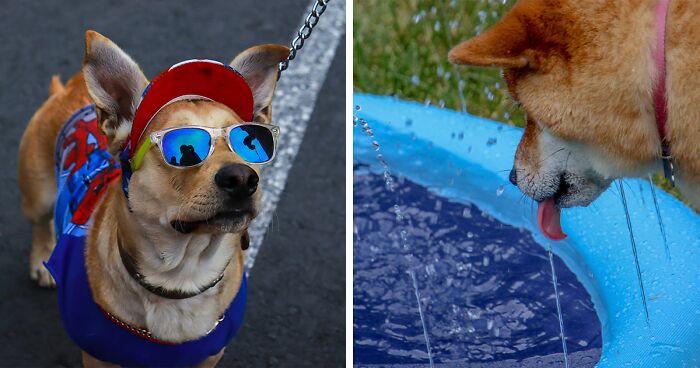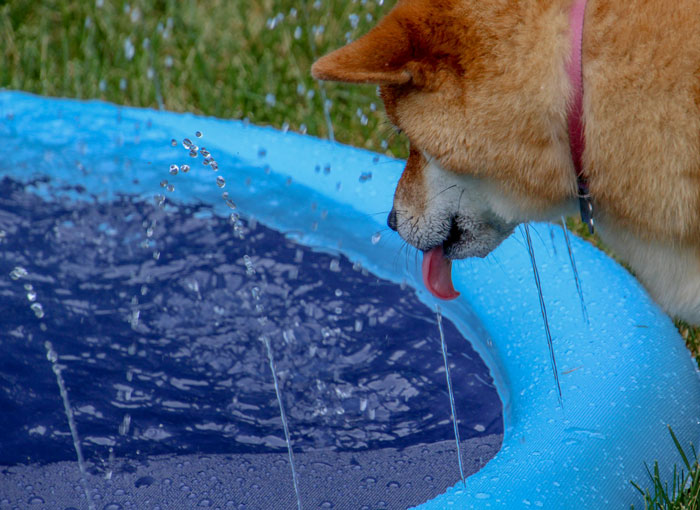As a dog owner, I love nothing more than a good walk with my furry best friend. But as the temperatures start to climb, a simple stroll can turn dangerous surprisingly fast. Did you know that a dog can get heatstroke even on a mildly warm day? It’s true! Our dogs are far more sensitive to heat than we are.
That’s why knowing exactly when the heat becomes a hazard is important.
So, keep reading if you’re wondering, “Is it too hot to walk my dog?” or how to protect those precious paws from scorching pavement. I have everything you need to keep your dog safe and comfortable through those hot summer months.
The information provided herein is for informational purposes only. Please refer to our disclaimer for more details..
There’s No Single “Too Hot” Temperature
Forget about searching for one magic temperature that means playtime is over. Your dog’s safety in the heat is about way more than just the number on the thermometer. Several factors work together to determine how your dog will handle the weather.
Think of it like this: we all have that friend who thrives in the summer heat, while another constantly complains of being too hot. Dogs are the same way! Just like humans, their individual characteristics play a huge role in how they handle warm weather. Here’s what you need to consider:
- Breed Matters: If you have a brachycephalic dog breeds like Bulldog, a Pug, or a Shih-Tzu, their adorable flat faces come with a downside – it’s harder for them to breathe and cool down. Huskies, with their thick double coats, are built for the snow, not the sun. Giant breeds simply have more mass to retain heat.
- Age is a Factor: Puppies and senior dogs often struggle to regulate their temperature efficiently. It’s like their internal thermostats aren’t quite as precise.
- Health Plays a Role: Overweight dogs or those with underlying heart or respiratory problems are at much higher risk. Imagine walking in hot weather while carrying extra weight or struggling to take a full breath – that’s what heat stress feels like for these pups.
- Location and Adaptation: A dog acclimated to a warmer climate will do better than one suddenly visiting from a cooler region. That said, never assume acclimation is a shield against heat stroke.
What about those temperature guidelines?
Once you cross into the 80s (°F), the risk of heat stroke starts to climb. Above 89°F, it’s downright dangerous for most dogs. But remember, some pups can overheat well below that point, especially those thicker-coated, short-faced breeds or dogs with health concerns.
Temperature Guidelines – How Hot Is Too Hot for Dog Paws
Realistically, you want to enjoy walks with your furry friend, even when the weather warms up. So, while there’s no magic number to memorize, here are some guidelines to help you make safe decisions about walking your dog on a hot day:
- Up to 65°F (18°C): Safe for most dogs, regardless of breed, health, or age.
- 65-70°F (18-21°C): Proceed cautiously, especially for higher-risk breeds (like brachycephalics, double-coated, or those with heart/lung problems). Keep walks short and shady, and offer plenty of water.
- 70-75°F (21-24°C): Risk level is increasing. Limit outdoor playtime and focus intensely on keeping your dog hydrated and cool.
- 75-80°F (24 -27°C): Significantly elevated risk for many dogs. Only brief walks, if any, and prioritize finding ways to exercise them indoors if possible.
- 80-85°F (27-29°C): This is approaching the danger zone for most dogs. Walks should be extremely short and only if absolutely necessary. Seek out water play or air-conditioned environments for exercise.
- 85-90°F (29-32°C): High-risk territory! For most dogs, this temperature is too dangerous for traditional walks. If venturing outdoors is unavoidable, keep it incredibly brief, with water constantly available.
- 90°F+ (32°C+): Critically dangerous, even potentially life-threatening, for many dogs. Avoid outdoor exercise entirely unless you have immediate access to large bodies of water for your dog to cool down in.
Remember, these are just guidelines. I’ve seen fit Labrador Retrievers start showing heat stress in the low 80s, while my neighbor’s French Bulldog struggles even on some milder 70-degree days.
Temperature becomes even more intense if your dog is a senior, overweight, or has a known medical condition.
It’s all about knowing your dog’s limits and playing it safe. A brief walk in those higher temperatures might be fine for your healthy, active dog, but it’s a recipe for trouble for others. Don’t get caught up in comparisons – focus on protecting your furry friend.
The Importance of Humidity
Temperature alone doesn’t tell the whole story regarding heat risk. Humidity is a silent factor that can turn a moderate day into a danger zone.
Your dog’s main way of cooling down is panting. It’s like their personal evaporative air conditioner, where the moisture from their tongue and lungs evaporating into the air helps lower their body temperature.
However, evaporation becomes far less efficient when the air is already saturated with moisture (high humidity). It’s like trying to run a fan in a steamy bathroom – it also doesn’t work.
Things get tricky here: a humid day at 75°F can be more dangerous than a dry day at 85°F. This is why paying attention to the humidity level is just as important as looking at the temperature.
To simplify it, there’s a handy guideline: add the air temperature in Fahrenheit to the humidity percentage. If the total is 150 or higher, it’s time to rethink those outdoor adventures.
For example, a day that’s 80°F with 80% humidity puts you well over that limit, even though the temperature itself might not seem extreme.
Check the Pavement Temperature
Ever walked barefoot on scorching summer asphalt? Remember that burning sensation? Now imagine that on your dog’s delicate paw pads. Sadly, even well-meaning dog owners underestimate how quickly surfaces like pavement, concrete, and even sand can heat up to dangerous levels.
The problem is air temperature doesn’t tell you how hot the ground is. Asphalt and concrete absorb and radiate heat, often becoming far hotter than the surrounding air. This means trouble for your dog’s paws, even on days that might not feel overly hot to you.
Here’s the “5-second rule”: Press the back of your hand firmly against the pavement. If you can’t comfortably hold it there for at least five seconds, it’s too hot for your dog. Their paws are tougher than ours but nowhere near tough enough to handle that kind of heat.
The dangers of hot pavement are more than just discomfort:
- First and second-degree burns: These painful blisters can form on paw pads with just a minute or two of direct contact with scorching surfaces.
- Overheating: Even if paws avoid burns, walking on hot ground raises your dog’s overall body temperature, rapidly increasing the risk of heat stroke.
- Long-term damage: Repeated exposure to hot pavement can toughen paw pads, making them more prone to cracking and injuries.
What to do instead?
- Timing is everything: Prioritize walks during the coolest parts of the day – early mornings and after sunset.
- Seek out the shade: If you must walk during warmer hours, stick to grassy areas or trails with shaded paths whenever possible.
- Consider booties: Protective booties can offer a layer of defense for dogs walking on unavoidable hot surfaces frequently (like urban settings with limited greenery).
- Hydration is key: Always provide access to fresh, cool water before, during, and after any walk, especially in warmer weather.
Don’t underestimate the risk of hot pavement. This extra step will help keep your dog’s paws healthy and happy, preventing unnecessary pain and potential long-term issues.
Signs of Heat Stroke and Overheating
Knowing how to spot the early signs of heat exhaustion can make a life-or-death difference for your dog. Pay close attention to these signals – quick intervention is critical:
Early Warning Signs
- Excessive panting and drooling.
- Bright red gums and tongue.
- Increased thirst.
- Restlessness or agitation.
- Weakness or lethargy.
- Changes in breathing (rapid, shallow, or noisy).
Serious Signs Requiring Immediate Emergency Care
- Vomiting or diarrhea.
- Disorientation, stumbling, or collapse.
- Muscle tremors or seizures.
- Unconsciousness.
How to Prevent Heat Stroke in Dogs
- Be aware of your dog’s risk factors.
- Plan walks and outdoor time strategically.
- Always provide water and opportunities for shade.
- Know the signs and act quickly if you see them.
- Never, ever leave your dog unattended in a car.
How to Respond to Heat Stroke
If you suspect heatstroke, time is of the essence. Here’s what to do:
- Cool them down immediately: Move your dog to a shaded area. Apply cool (not ice-cold) water to their body, focusing on the groin and armpit areas. You can also offer small amounts of cool water to drink.
- Get to the veterinarian ASAP: Heatstroke is a life-threatening emergency. Even if your dog seems to be improving with cooling, they need immediate veterinary care from DVM specialists for the best possible outcome.
Remember, an ounce of prevention is worth a pound of cure. Proactive measures will go a long way in protecting your four-legged friend against the dangers of excessive heat.
1Kviews
Share on Facebook
 Dark Mode
Dark Mode 

 No fees, cancel anytime
No fees, cancel anytime 







 Image credits:
Image credits:  Image credits:
Image credits:  Image credits:
Image credits: 










































0
0